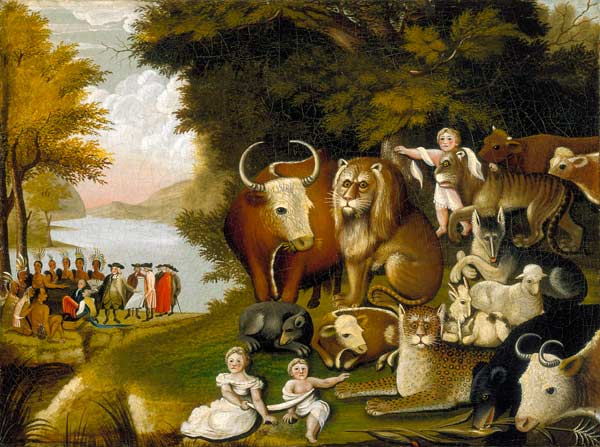0
During Advent we often hear in the Scripture readings from Isaiah, the prophet, who paints his vision for the future, a compelling vision that has often been named “the peaceable kingdom.” He speaks of a vision of a new heaven and new earth; of life coming out of destruction; a shoot sprouts from the seemingly dead stump of the tree; the wolf and the lamb will lie down together, no one shall hurt or destroy on God’s holy mountain. Paradise will be restored, all nature will sing in harmony. He is painting a picture of what peace looks like.
That vision was inspirational to a fellow named Edward Hicks from Bucks County, Pennsylvania. He was a Quaker minister and to make a little extra income, he painted, mostly tavern signs, farm equipment, whatever was most needed and he was good at it. He began to make a fair amount of money doing it, and this upset his Quaker congregation, who felt he was violating their customs of simple living. It caused quite a split in the members of his congregation, so he gave it up and became a farmer. Trouble was, he was a terrible farmer. He gave that up and the preaching ministry too. However, he discovered he could use his painting to express his faith and he began to draw oil paintings based on this reading from Isaiah, Chapter 11. He created over 100 versions of it and today we know it as his best known work titled: “The Peaceable Kingdom.”
In most of the paintings the predator and the prey are together. There is a bull, a lion, a lamb, a bear, a child. For Hicks the animals reflected something of our temperaments—the lion was anger, the bear was calmness. Maybe it calls us to ask ourselves, “What is the lion in me and what is the lamb?” “How do I reconcile both within me?” In another part of the painting he had William Penn conducting a treaty with the Indians. A river flows toward them, and light shines upon them. Perhaps this was to show us that the Spirit, the light placed within us by God, helps us to dwell together in peace, despite our animosities and our differences. It could be that Edward Hicks was inspired to paint this picture over and over because he was obsessed with a vision of peace. You might be thinking, “Well, how is a 200 year old painting relevant for me?”
I think it’s relevant because you and I struggle with the very same questions? What is our vision of peace? Is it a restored relationship? Is it a decision to help those who have been treated unjustly? Is it our acceptance of being co-creators of a peaceable kingdom for the future? Is it a world free of war?
Unfortunately, there is so much hurt and animosity in our world today. As we end this year and get ready to begin a new one, I think again of Isaiah… what does he do? He portrays to the people of Israel a message of hope. That what God has cut off is also that which God restores. That the One who judges His people for their sins, is also the One who forgives them and restores Peace. Isaiah’s message to Israel and to us is the need to know and believe in the Prince of Peace. To believe not only in the Incarnation of the Messiah that we just celebrated, but to believe that each day the Incarnate Word of God lives in us too. Isaiah holds out hope to us that we can change, that we can be transformed, that grace working in human nature accomplishes so much more than we could ever imagine. The prophet grew old and yet he continued to watch and wait, all the time proclaiming the Messianic hope. He does what God’s people have always done: he sits still long enough, listens closely enough, discerns carefully enough, and it becomes clear. We step back, take the long view, and ask “What does God want us to see?” It is a moment when the message and meaning of Advent and Christmas emerges.
We know that Christmas is the time when we, perhaps, more fully remember that God is indeed Emmanuel–“God-with-us.” This conviction is the grounding for the peace of which we speak at Christmas, the peace for which we all so earnestly yearn. We find that peace in openness to others, in the kindness of others to us, in living lives of integrity, honesty and respect. Peace calls for a change of mind and heart. The peaceable kingdom of God for which we long is possible.
Isaiah gives us the vision of the prophet, the artistry of the painter and the provision of daily bread if we have eyes to see and ears to hear. If we sit still long enough, if we listen closely enough, if we discern carefully enough, the vision will become clear. In this New Year and in the days beyond, we can graft our lives to the shoot that has emerged from the stump of Jesse, and pray for his peace to fill us and transform us. I pray we can open our eyes, ears, hearts and hands to be promoters of the peaceable kingdom here, now, and in the days to come.
Happy New Year!
Barbara McMullen, CDP
photo: “Peaceable Kingdom” by Edward Hicks
Related Stories



